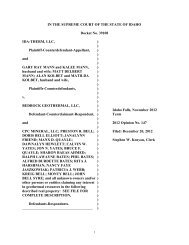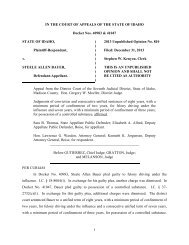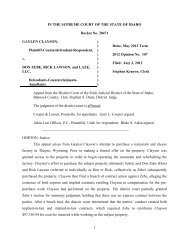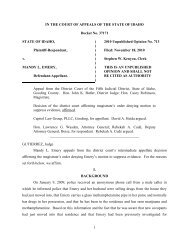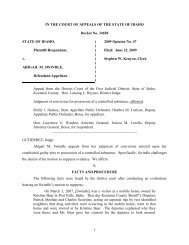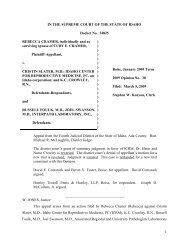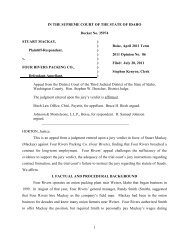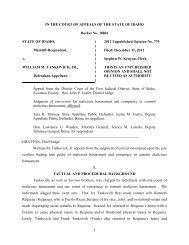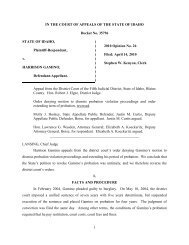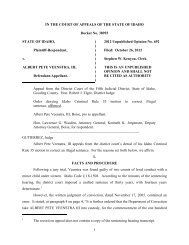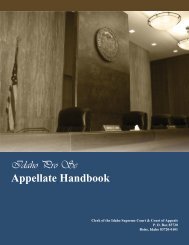April 1, 2013 State v. Hector B. Almaraz, Jr. - Idaho State Judiciary
April 1, 2013 State v. Hector B. Almaraz, Jr. - Idaho State Judiciary
April 1, 2013 State v. Hector B. Almaraz, Jr. - Idaho State Judiciary
You also want an ePaper? Increase the reach of your titles
YUMPU automatically turns print PDFs into web optimized ePapers that Google loves.
tape recorder was turned off before Hust’s identification, and Hust did not testify at trial that any<br />
of Officer Sloan’s actions led him away or toward identifying the defendant, we only have the<br />
officer’s testimony as evidence to the level of certainty demonstrated. These facts together with<br />
the potential for confirmation feedback weigh against reliability.<br />
Finally, in analyzing the fifth factor, the length of time between the shooting and the<br />
identification was reasonable and did not detract from the overall reliability of the identification.<br />
Three days elapsed between the shooting and Hust’s identification and courts have found this<br />
time period to be acceptable. 12 See e.g., <strong>State</strong> v. Gray, 129 <strong>Idaho</strong> 784, 797, 932 P.2d 907, 920<br />
(Ct. App. 1997).<br />
Of the five factors, only the fifth factor is unquestionably in favor of reliability. The<br />
other four factors each have specific shortcomings that call into question the reliability of the<br />
identification. Additionally, as we noted above, confirmation feedback from overly suggestive<br />
police procedures can impact an eyewitness’s level of certainty in their identification. This is<br />
especially troublesome given the unexplained turning off the tape recorder before the interview<br />
was complete. After balancing these five reliability factors against the suggestive elements of<br />
the identification, the reliability of the identification fails to outweigh the impact of the<br />
suggestive circumstances. Therefore, this Court holds that the district court erred in admitting<br />
Hust’s identification because the suggestiveness of the identification procedure was not<br />
outweighed by independent indicia of reliability.<br />
3. Whether the <strong>State</strong> met its burden of proving that the district court’s erroneous<br />
admission of Hust’s identification of <strong>Almaraz</strong> into evidence was harmless.<br />
Where a defendant alleges error at trial that he contemporaneously objected to, this Court<br />
reviews the error on appeal under the harmless error test. <strong>State</strong> v. Perry, 150 <strong>Idaho</strong> 209, 222,<br />
245 P.3d 961, 974 (2010). If the Court finds that the district court abused its discretion in<br />
admitting or excluding the evidence, then the Court must declare a belief beyond a reasonable<br />
doubt that the error did not affect the outcome of the trial, in order to find that the error was<br />
harmless and not reversible. Id. at 227–28, 245 P.2d at 979–80. In other words, the error is<br />
harmless if the Court finds that the result would be the same without the error. See id. In Perry,<br />
this Court applied the standard of harmless error for a constitutional violation found in the<br />
United <strong>State</strong>s Supreme Court opinion in Chapman v. California, 386 U.S. 18 (1967). “Under the<br />
12 Additionally, the three days that elapsed between the shooting and Hust’s identification provided the investigators<br />
with ample time to construct a proper line-up.<br />
16



